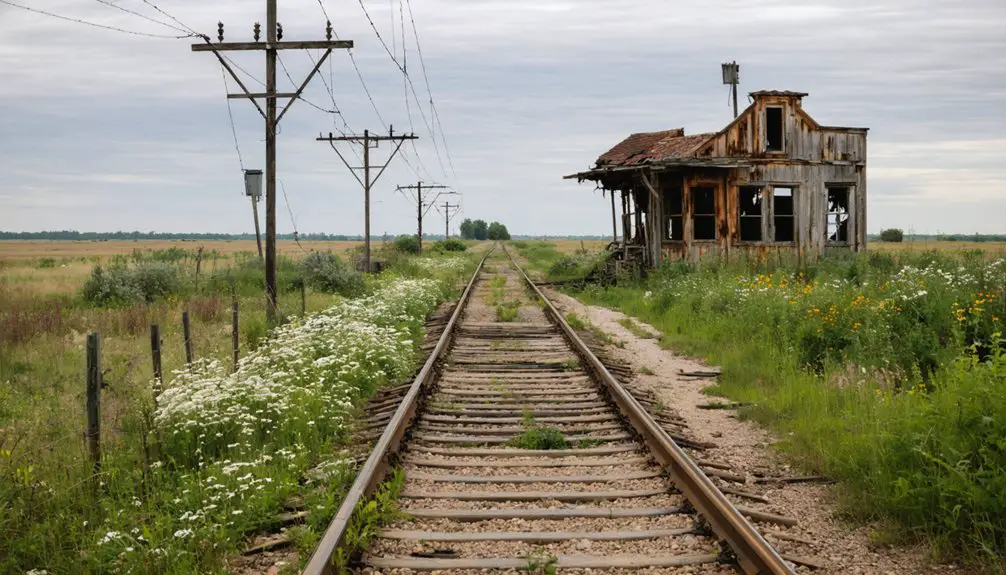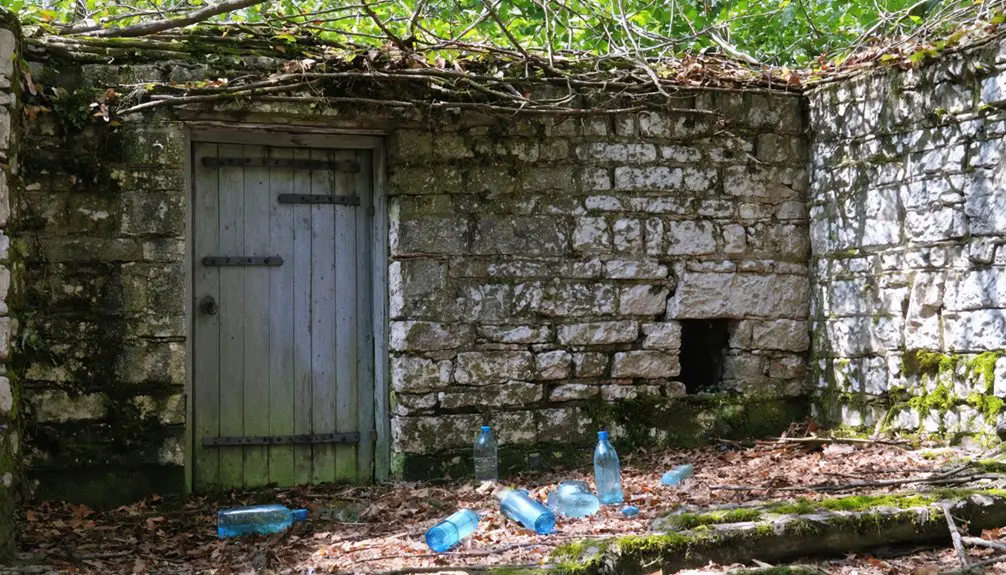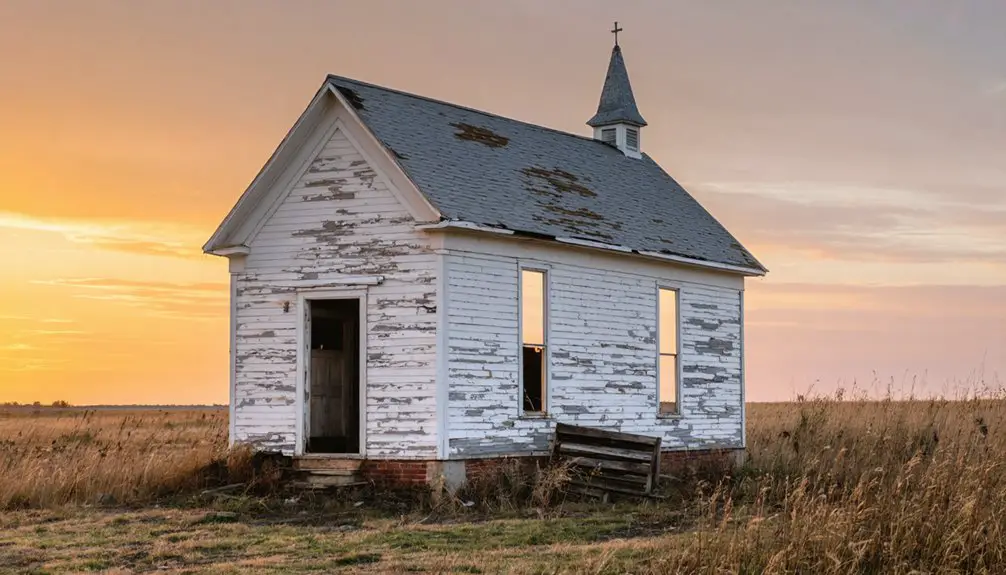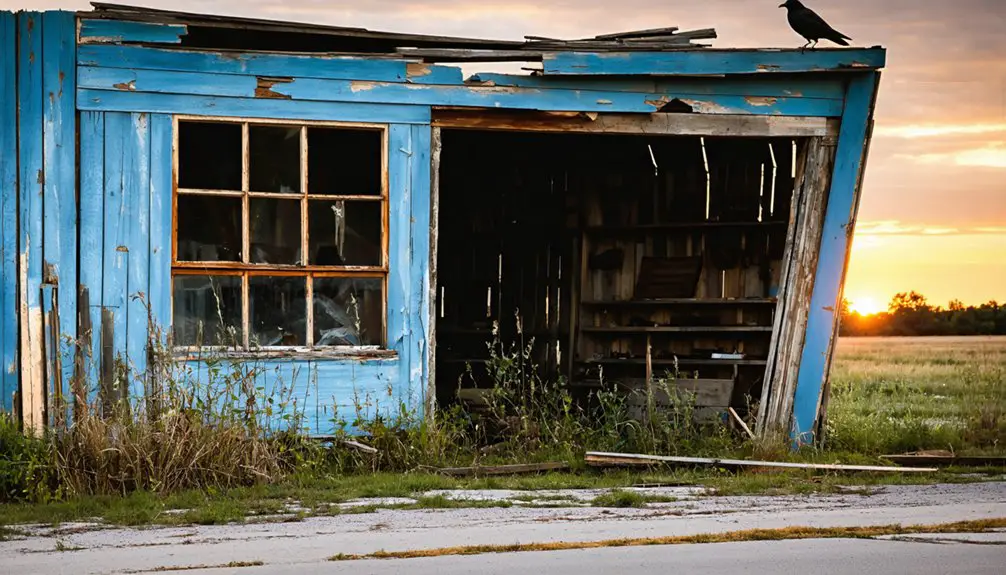You’ll find Huntville’s ruins in Kingfisher County, Oklahoma, where this frontier settlement once thrived before declining into a ghost town by the mid-1900s. The town’s early prosperity came from farming, resource extraction, and liquor sales to neighboring dry territories. Though major railroads bypassed Huntville in favor of towns like Adams and Kingfisher, archaeological evidence reveals over thirty structure foundations, including brick hearths and limestone chimneys. The town’s story mirrors thousands of other Oklahoma settlements that rose and fell with America’s westward expansion.
Key Takeaways
- Huntville was an early Oklahoma frontier settlement in Kingfisher County that eventually became a ghost town after significant population decline.
- The town’s economy initially thrived on resource extraction, liquor sales, and local businesses before experiencing devastating economic decline.
- Major railroad lines bypassed Huntville in favor of neighboring towns like Adams and Kingfisher, severely impacting its economic viability.
- Archaeological evidence revealed over thirty structures and diverse artifacts, including ceramics and metal items from 19th-century frontier life.
- The town’s population decreased by over 80% as younger generations left for urban opportunities and essential services shut down.
The Rise and Fall of a Frontier Settlement
When settlers first established Huntville in Kingfisher County during Oklahoma’s frontier era, they envisioned a thriving agricultural community built on the region’s fertile soil.
Despite early settler challenges, the town developed essential infrastructure including general stores, a post office, schools, and churches to support local farmers and ranchers. Like many of Oklahoma’s estimated two thousand ghost towns, Huntville represented the pioneering spirit of territorial expansion. The community’s resilience showed in its steady growth through the early 1900s. Many residents relied on liquor sales to neighboring dry territories for additional income.
However, Huntville’s promising trajectory changed dramatically when major railroad lines bypassed the settlement.
You’ll find this was a decisive turning point, as neighboring towns with rail access began attracting businesses and residents away from Huntville. Competition from Adams and Kingfisher, coupled with changing transportation patterns, gradually eroded Huntville’s economic foundation.
The town’s population eventually declined by over 80%, transforming it into the ghost town you’ll see today.
Location and Geographic Significance
Nestled in the northeastern region of Haskell County, Oklahoma, Huntville’s strategic position near the Canadian River shaped its early development and ultimate fate.
You’ll find the settlement’s remains amid rolling hills and gentle plains, where dirt roads and wagon trails once connected local homesteaders to essential trade routes.
The town’s location served as a significant waypoint for travelers, supporting surrounding farms and ranches despite its geographic isolation.
Like many settlements during Oklahoma’s oil boom, the town experienced a brief period of growth as prospectors and merchants sought opportunities in the region.
While the semi-arid climate and variable rainfall challenged early settlers, the moderate elevation offered some protection from flooding.
However, the town’s distance from major railroad lines ultimately hindered its growth potential.
Dual sport motorcycles provide the ideal means of accessing and exploring these remote ghost town locations.
Today, you can reach what’s left of Huntville primarily by gravel roads, where the prairie winds whisper tales of its frontier past.
Early Settlers and Community Formation
You’ll find the earliest settlers of Huntville, Oklahoma arrived in the late 1820s, with families traveling overland from Missouri or via the Arkansas River to establish new homes.
The pioneer families, including the Vaughan brothers and notable figures like Henry King and George Tucker, scouted the land before establishing permanent settlements focused on farming. Like early settlers elsewhere, they lived in small log cabins while working to clear their plots of land.
These initial settlers constructed basic log homes and quickly formed a farming community that would lay the foundation for Huntville’s brief but significant history. Among the area’s first inhabitants were the Bidai Native Americans, who had maintained a presence in the region until an epidemic drastically reduced their population.
Pioneer Settlement Patterns
During the early 1800s, pioneer settlement in Huntsville emerged around Hunt’s Spring, where Daniel Hunt established the first homestead on a strategic bluff.
Early pioneer demographics reveal settlers primarily came from Tennessee and Alabama, following established trails to stake their claims in this promising territory.
You’ll find these early settlers chose their locations carefully, clustering near crucial water sources that supported their survival needs.
While the Osage, Cherokee, Chickasaw, and Shawnee had previously claimed these hunting grounds, land treaties in 1808 and 1825 opened the region to American settlement.
The community grew steadily as newcomers arrived, spurring the development of essential institutions.
Farming Community Establishment
As pioneers settled Huntsville in the 1890s, farming quickly emerged as the community’s economic backbone, with families establishing homesteads on plots carefully selected for their fertile soil and proximity to Hunt’s Spring.
You’ll find that these early settlers developed resilient farming techniques adapted to Oklahoma’s challenging climate, focusing on both subsistence crops and small commercial ventures.
The community’s shared infrastructure grew around agricultural needs, with a general store and one-room schoolhouse serving as essential gathering places. Like many communities that would later face economic booms and busts, Huntsville’s early development centered on creating sustainable agricultural practices.
Similar to the struggles of Tar Creek residents, these farming families had to eventually relocate due to environmental concerns.
You can trace how farming families built strong social bonds through cooperative labor during planting and harvest seasons.
Their community resilience showed in how they managed shared resources and resolved disputes through informal local governance, while religious gatherings and educational activities strengthened their social fabric.
Economic Activities and Local Industries
While many Oklahoma ghost towns followed similar paths to abandonment, Huntville’s economic story centered primarily on resource extraction and its inevitable boom-bust cycle.
Oil company camps provided better living conditions than most available housing options for workers.
The town’s mining impacts were typical of the era, with workers flooding in during peak operations and local businesses sprouting up to serve the growing population.
During the boom years, you’d have found a bustling main street lined with grocery stores, saloons, and hotels catering to the transient workforce.
Picture a lively main street bustling with shops, saloons, and hotels serving the steady stream of workers passing through.
Oil extraction operations further fueled the local economy, creating jobs and attracting more residents.
Like many boomtowns of the period, Huntville’s businesses thrived as long as the resources held out.
Much like the fate of early Kusa settlers, the town’s population dwindled when economic opportunities vanished.
However, once the mining and oil industries began to consolidate and resources depleted, the town’s commercial enterprises couldn’t sustain themselves, leading to inevitable closure.
Transportation Networks and Their Impact

Once pioneer trails carved essential pathways through eastern Oklahoma, Huntville’s fate became inextricably linked to the region’s evolving transportation networks.
Early routes like the Osage Trace and Texas Road established crucial corridors for trade and settlement, with the Texas Road’s legacy living on through modern U.S. Highway 69.
The transportation evolution brought dramatic changes as railroads transformed Oklahoma’s landscape.
You’ll find that towns’ survival often hinged on securing a coveted rail station – those bypassed frequently faced economic decline.
When the era of highways dawned, communities faced another significant moment.
Huntville’s story mirrors many Oklahoma ghost towns where shifting transportation patterns spelled their doom.
Whether cut off from rail lines or bypassed by modern highways, the loss of crucial transportation connections often triggered the final chapter in these towns’ existence.
Daily Life in Historical Huntville
The daily rhythm of historical Huntville centered on your hard work in the mines or supporting businesses, where you’d spend long hours extracting lead and zinc or running essential services like general stores.
After work, you’d find community connection at the town’s saloons and gathering spots, joining neighbors for dances, fairs, and shared meals that helped combat the isolation of rural Oklahoma life.
When times got tough, you’d rely on informal support networks of fellow townspeople, sharing resources and helping each other through seasonal employment fluctuations and mining-related health challenges.
Social Gatherings and Events
During Huntville’s peak years, social gatherings served as the heartbeat of this Oklahoma community, where dance halls and saloons buzzed with activity typical of frontier towns.
You’d find men gathering at saloons after long days of work, sharing stories and playing games while building lasting bonds of camaraderie.
Community events brought together the town’s diverse mix of miners, traders, and families for seasonal celebrations and outdoor gatherings.
The social dynamics reflected the era’s demographic reality, with men often outnumbering women in these frontier settlements.
Churches and schools, when present, provided structured social occasions for families, while dance halls offered entertainment for both residents and travelers.
Like many Oklahoma towns before statehood in 1907, these social institutions flourished until population decline gradually dimmed the town’s vibrant social scene.
Work and Trade Activities
Agricultural activities formed the backbone of Huntville’s economic life, with family farms dotting the landscape and sustaining the mainly Black community through crop cultivation and small-scale trade.
The town’s trade dynamics revolved around essential businesses like general stores, blacksmith shops, and women’s boutiques, where you’d find local entrepreneurs providing crucial services.
Labor practices centered on manual skill and seasonal rhythms, with farmers using horse-drawn equipment and craftsmen maintaining tools and infrastructure. You’d see blacksmiths repairing farm implements and shoeing horses, while tailors crafted clothing for the community.
Though limited by transportation constraints and market access, Huntville’s residents maintained economic independence through local commerce and skilled trades, adapting to the challenges of pre-industrial life while building a self-reliant community.
Community Support Networks
Life in Huntville revolved around robust community networks that touched every aspect of daily existence.
You’d find community resilience demonstrated through churches and schools serving as crucial gathering spaces, while the general store buzzed with news exchanges and neighborly support. Local families relied on mutual aid practices, sharing tools and labor for demanding tasks like barn-raising and harvests.
During hardships, you’d witness the town’s strength as neighbors provided food, supplies, and care for the sick. The post office and bulletin boards kept everyone connected, while traveling salesmen brought news from beyond.
Social bonds grew stronger through community dances, picnics, and quilting bees. Church socials and seasonal festivals united residents, creating the supportive atmosphere that defined Huntville’s character before its eventual decline.
Factors Leading to Abandonment
The depletion of zinc and lead deposits in Huntville’s mining operations sparked a devastating chain reaction that ultimately led to the town’s abandonment. As profitability declined and mining companies relocated, you’d have witnessed a rapid economic decline that forced residents to seek jobs elsewhere.
The environmental hazards left behind, including toxic heavy metals in soil and water, made the area increasingly uninhabitable. The town’s infrastructure crumbled as essential services shut down, while dangerous ground subsidence from mining tunnels threatened building stability.
You’ll find that younger generations moved to urban centers offering better opportunities, leaving behind an aging population. The combination of contaminated land, failing services, and lack of economic alternatives sealed Huntville’s fate as residents gradually abandoned their homes.
Physical Remnants and Archaeological Evidence

Archaeological investigations at Huntville have revealed foundations and remnants of over thirty structures, including barracks and employee quarters with distinctive architectural elements like brick hearths and limestone chimneys.
You’ll find evidence of typical 19th-century frontier construction throughout the site, including nails, wooden framing components, and rare picket-style log buildings.
The excavated artifact assemblage features ceramics with burnt residue, metal items like buttons and iron pots, and Native American artifacts such as projectile points, demonstrating the site’s layered cultural history.
Foundations and Building Sites
Extensive remnants of Huntville’s original settlement reveal a substantial community through its preserved foundations and architectural features.
You’ll find evidence of over thirty buildings constructed with diverse building materials including brick, limestone, and wood. The foundations showcase both stone and brick construction, with distinctive picket-style log building techniques that were uncommon in the region.
Throughout the site, you can observe brick hearth remnants and limestone chimney foundations that indicate residential structures, while wood cellar depressions point to underground storage areas.
The construction techniques are documented through archaeological excavations revealing 18-22 inches of cultural deposits. Though the site has suffered from looting and vandalism, remaining structural elements provide essential insights into the settlement’s layout and building practices through careful stratigraphic analysis and grid-based mapping.
Excavated Artifacts and Materials
Beyond the structural remains, rich deposits of artifacts and materials at Huntville offer compelling evidence of human occupation spanning multiple periods.
Through careful artifact analysis, you’ll find projectile points dating to the Archaic period alongside various lithic tools like knives, scrapers, and grinding stones that reveal a mixed hunting-gathering economy.
Pottery sherds displaying bird claw motifs suggest Mississippian cultural influences, while burnt ceramics indicate cooking activities.
The site’s cultural implications extend through time, from prehistoric bison and mammoth hunters to historic settlers who left behind metal items like nails, buttons, and iron pots.
Despite some looting damage, stratigraphic excavations have preserved essential contextual evidence, allowing you to trace Huntville’s remarkable transformation from ancient settlement to ghost town.
Historical Records and Documentation
Through detailed census records and archival documentation, researchers have traced Huntville’s dramatic rise and fall as an Oklahoma settlement.
Like many ghost towns in the region, you’ll find census discrepancies that reflect the boom-and-bust cycle, with population counts showing dramatic swings of up to 80% during decline phases.
Post office records serve as essential markers of Huntville’s active period, similar to other Oklahoma ghost towns like Hext, whose brief official existence lasted just one year.
Post office records tell the life stories of ghost towns, marking their brief moments of vitality before fading into history.
You can track the town’s liveliness through infrastructure documentation, including WPA-built schools, churches, and transportation routes.
These records paint a clear picture of economic shifts that ultimately led to abandonment – from resource depletion to changing transportation patterns.
When cross-referenced with business directories and local government archives, you’ll see the town’s gradual shift into ghost town status.
Legacy in Oklahoma’s Ghost Town Heritage

Huntville’s ghost town status embodies Oklahoma’s complex legacy of economic booms and busts, where thousands of settlements rose and fell with the state’s evolving fortunes.
You’ll find its story woven into the cultural narratives that define early Oklahoma life, from mining camp communities to prohibition-era border towns.
Like many ghost towns across the state, Huntville faced environmental challenges that hastened its decline.
Mining operations left lasting impacts on the land, similar to the infamous toxic legacy of nearby Picher.
You can trace the town’s fate through changes in transportation networks and infrastructure development that reshaped Oklahoma’s landscape.
Today, Huntville stands among roughly two thousand ghost towns that remind you of the state’s dynamic past, where resource-dependent communities often proved as temporary as the boom times that created them.
Frequently Asked Questions
Were There Any Notable Crimes or Outlaws Associated With Huntville?
You won’t find documented outlaw history or major crime incidents linked to this location – historical records don’t show any notable criminal activity that stands out from typical frontier-era disturbances.
What Native American Tribes Originally Inhabited the Huntville Area?
You’ll find the Five Civilized Tribes, particularly the Cherokee and Creek, dominated this area’s tribal history. Their cultural significance shaped the region before forced relocation to Indian Territory in the 1830s.
Did Any Famous People Ever Live in or Visit Huntville?
Like footprints in shifting sand, you won’t find traces of famous visitors or historical figures here. There’s no documented evidence of any notable personalities ever living in or passing through.
What Natural Disasters Affected Huntville During Its Inhabited Period?
You’ll find that tornadoes regularly struck the area during Huntville’s existence, while floods from nearby waterways caused significant damage. Severe storms, destructive hail, and regional droughts also plagued your early settlers.
Are There Any Local Legends or Ghost Stories About Huntville?
You won’t find documented ghost sightings or haunted locations specific to Huntville in historical records, though nearby mining towns like Picher and Hockerville have well-known tales of supernatural activity.
References
- https://en.wikipedia.org/wiki/List_of_ghost_towns_in_Oklahoma
- https://www.okhistory.org/publications/enc/entry?entry=GH002
- https://okmag.com/blog/a-ghostly-site/
- https://kids.kiddle.co/List_of_ghost_towns_in_Oklahoma
- https://www.redriverhistorian.com/ghost-towns
- https://www.wikiwand.com/en/articles/List_of_ghost_towns_in_Oklahoma
- https://echo.snu.edu/the-ghost-towns-of-oklahoma/
- https://www.arcadiapublishing.com/collections/arcadia-publishing-new-releases/bisac-history-united-states-state-local-southwest-az-44-nm-44-ok-44-tx?page=9&phcursor=eyJhbGciOiJIUzI1NiJ9.eyJzayI6InByb2R1Y3RfY3JlYXRlZF9hdCIsInN2IjoiMjAyMy0wMy0yMVQxNDowMjoxNC4wMDBaIiwiZCI6ImIiLCJ1aWQiOjM3Mzc3MDgwNjg4OTM2LCJsIjozNSwibyI6MCwiciI6IkNEUCIsInYiOjF9.UE2DqAUavoPShTPCC67B0YuZS2oprL1gOwixAWG4DFs
- https://www.rideok.com/ghost-towns-of-oklahoma-gps-waypoints/
- https://en.wikipedia.org/wiki/Category:Ghost_towns_in_Oklahoma



